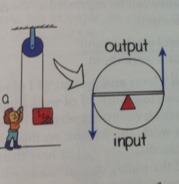Sign up for FlowVella
Sign up with FacebookAlready have an account? Sign in now
By registering you are agreeing to our
Terms of Service
Loading Flow







The axis of the pulley acts as the fulcrum, and both lever distances are equal so the pulley does not multiply force. It simply changes the direction of the applied force. In this case, the mechanical advantage equals one.
The fulcrum is at the end of the "lever", where the supporting rope makes contact with the pulley. The load is suspended halfway between the fulcrum and the input end of the lever on the right. Each newton of input supports 2N of load so the mechanical advantage is 2
Single Pulley (type 1 lever)
Single Pulley (type 2 lever)
The mechanical advantage of the pulley system
A complex pulley system





How does it work?
Although 3 strands of rope are shown, only 2 strands support the load. the upper pulley serves to change direction of the force. The mechanical advantage is two.
When the rope is pulled 5m with a force of 100 N, a 500N load is lifted 1m. The mechanical advantage is 5. Forces multiplied at the expense of distance. The mechanical advantage can also be found from the ratio of distances.
VIDEO
(stop at 1:06)